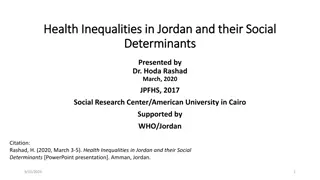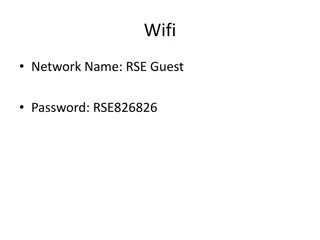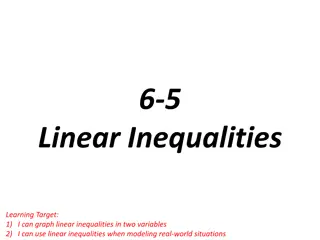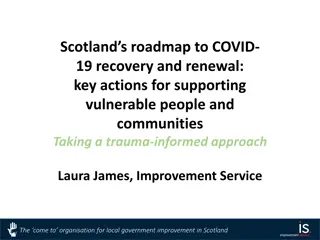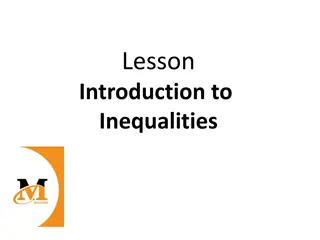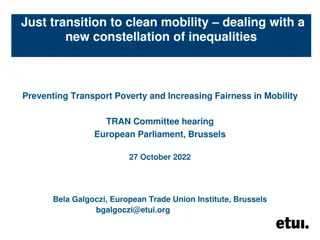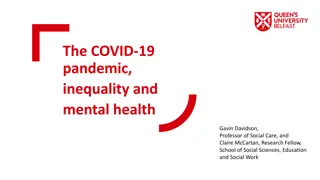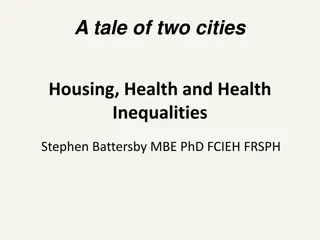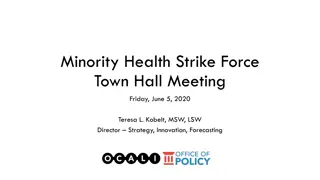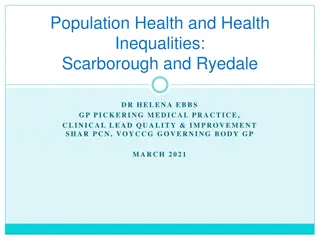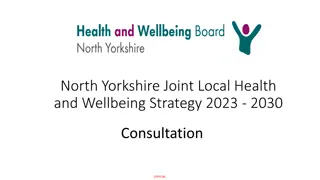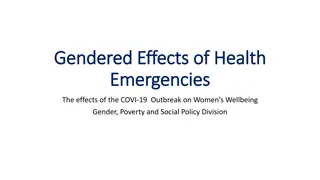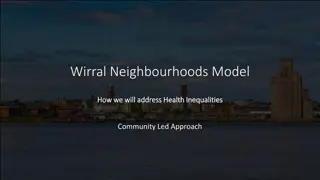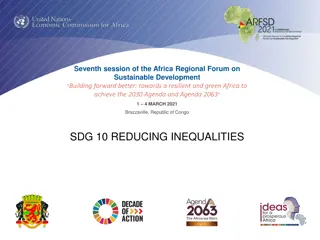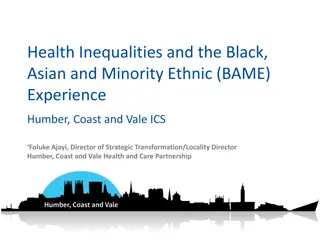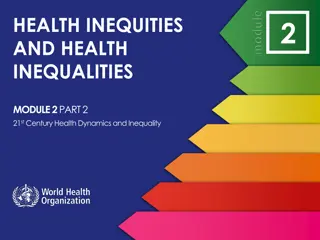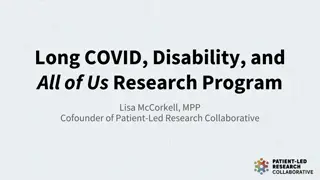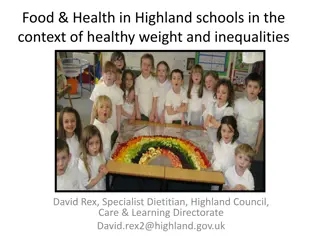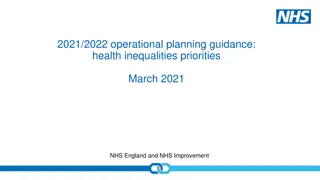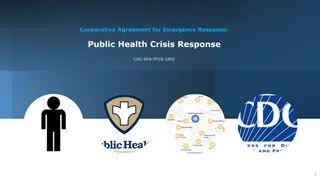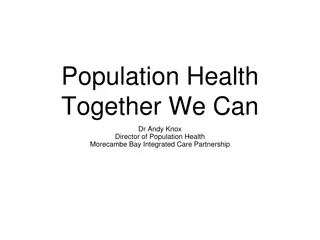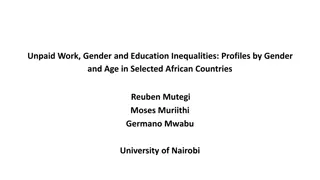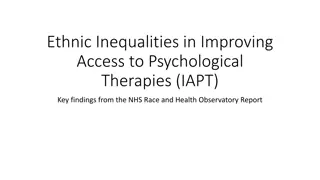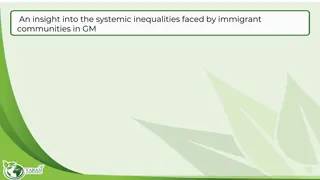Understanding COVID-19 Impact on Health Inequalities
This presentation delves into the intersection of COVID-19 and health inequalities, particularly focusing on disparities in Scotland. It highlights data on emergency admissions, socio-economic factors, and vulnerable groups disproportionately affected by the pandemic. The discussion explores causes for these disparities, such as high-risk key worker jobs and living conditions, emphasizing pre-existing health outcome inequalities. Further research on race, ethnicity, and urban areas is also addressed.
Download Presentation

Please find below an Image/Link to download the presentation.
The content on the website is provided AS IS for your information and personal use only. It may not be sold, licensed, or shared on other websites without obtaining consent from the author. Download presentation by click this link. If you encounter any issues during the download, it is possible that the publisher has removed the file from their server.
E N D
Presentation Transcript
COVID COVID- -19 and Health Inequalities 19 and Health Inequalities Diane Stockton Social and System Recovery Programme Lead
The Bare Statistics The Bare Statistics
Further work in progress Further work in progress Race and ethnicity particularly Black and Asian communities Observed differences in England; Scottish data to be published next week Socio-economic disadvantage Disproportionately from high risk key worker jobs More likely to live in densely populated urban areas Particularly true in London Vulnerable groups, including gypsy/travellers, drug users, homeless
Causes for the disparity in COVID Causes for the disparity in COVID Risk of contracting Disproportionately more likely to be in key worker jobs, and particularly, high risk key worker jobs Less likely to be able to work from home (10% vs 50%) More likely to have to travel on public transport to work More cramped housing conditions in some cases Outcomes We already had significant and persistent inequalities in health outcomes Pre-COVID there were unsustainable pressures on health and social care services impacting on poor health outcomes The virus is more acute for those who already suffer poorer health
Figure 1 The mechanisms through which the unintended population health impacts of the Non-Pharmaceutical Interventions (NPIs) may occur
Wider impact of lockdown Wider impact of lockdown Those on low wages are seven times as likely as high earners to have worked in a sector that has been shut down Increased food insecurity Increase in poor mental wellbeing - job insecurity, isolation Increase in domestic violence Differential impact for those in rented accommodation (the average renter spends a third of their income on housing compared with 17% of homeowners) Loss of job opportunities for our 16-25 year olds
The backdrop to the current challenge The backdrop to the current challenge Scotland s relative poor health and wellbeing Significant and persistent inequalities in health outcomes Unsustainable pressures on health and social care services
Infectious disease outbreaks, food supplies, wars Continuous improvement WWI and Spanish flu WWII Life expectancy in Scotland, 1855-2005
Along with a rise in inequalities : men & women <75 years Most deprived 10th Least deprived 10th
We have an economic theory for the pre-COVID life expectancy trends Pressures on: Social care NHS Local government Public spending squeezed Change to value and conditionality of social security benefits Wages squeezed Precarious work
We have an economic theory for the pre-COVID life expectancy trends Pressures on: Social care NHS Local government Public spending squeezed Change to value and conditionality of social security benefits Decreased incomes Increased poverty Decreased security Wages squeezed Precarious work
We have an economic theory for the pre-COVID life expectancy trends Pressures on: Social care NHS Local government Public spending squeezed Poor housing Poor nutrition Less ability to maintain healthy behaviours Risk of rough sleeping Destructive coping mechanisms Poor mental health Social isolation Change to value and conditionality of social security benefits Decreased incomes Increased poverty Decreased security Wages squeezed Precarious work
We have an economic theory for the pre-COVID life expectancy trends Pressures on: Social care NHS Local government Public spending squeezed Poor housing Poor nutrition Less ability to maintain healthy behaviours Risk of rough sleeping Destructive coping mechanisms Poor mental health Social isolation Stalling of most causes of death Change to value and conditionality of social security benefits Increased inequalities in mortality Decreased incomes Increased poverty Decreased security Wages squeezed Precarious work
The backdrop to the current challenge The backdrop to the current challenge Scotland s relative poor health and wellbeing Significant and persistent inequalities in health outcomes Evidence suggests these will increased through the impacts of COVID19 Increased financial insecurity and hardship Unsustainable pressures on health and social care services Current unmet need concern severe conditions coming through Build up of urgent care and capacity issues due to social distancing Building back to a different normal more focus on prevention, community and primary care Decreases in physical activity; increases in alcohol consumption
Figure 1 The mechanisms through which the unintended population health impacts of the Non-Pharmaceutical Interventions (NPIs) may occur
Our Social and System Recovery work programme Our Social and System Recovery work programme



